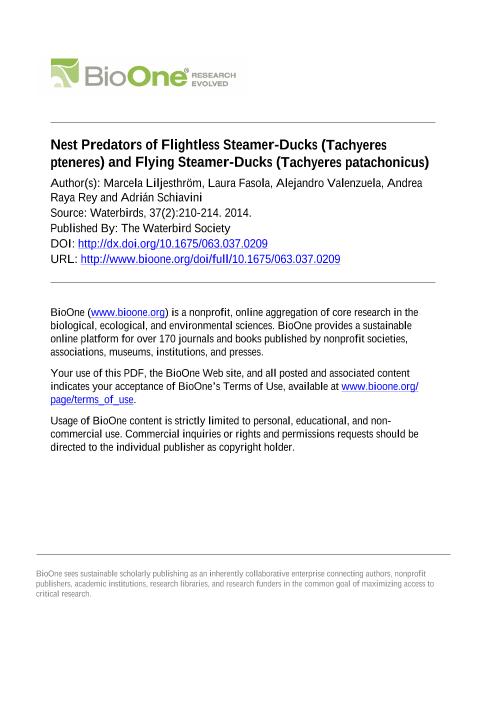Artículo
Nest predators of flightless steamer-ducks (Tachyeres pteneres) and flying steamer-ducks (Tachyeres patachonicus)
Liljesthrom, Marcela ; Fasola, Laura
; Fasola, Laura ; Valenzuela, Alejandro Eduardo Jorge
; Valenzuela, Alejandro Eduardo Jorge ; Raya Rey, Andrea Nélida
; Raya Rey, Andrea Nélida ; Schiavini, Adrian Carlos Miguel
; Schiavini, Adrian Carlos Miguel
 ; Fasola, Laura
; Fasola, Laura ; Valenzuela, Alejandro Eduardo Jorge
; Valenzuela, Alejandro Eduardo Jorge ; Raya Rey, Andrea Nélida
; Raya Rey, Andrea Nélida ; Schiavini, Adrian Carlos Miguel
; Schiavini, Adrian Carlos Miguel
Fecha de publicación:
11/2014
Editorial:
Waterbird Society
Revista:
Waterbirds
ISSN:
1524-4695
Idioma:
Inglés
Tipo de recurso:
Artículo publicado
Clasificación temática:
Resumen
A combination of infrared cameras and plasticine eggs were used to identify potential nest predators of Flightless Steamer-Ducks (Tachyeres pteneres) and Flying Steamer-Ducks (T. patachonicus) and to evaluate the relative efficacy of these methods for identifying predators. Cameras were set up at 31 artificial nests with plasticine eggs and at four Flightless and two Flying steamer-duck nests. Two avian predators, Chimango Caracara (Milvago chimango) and Southern Crested Caracara (Caracara plancus), and two mammalian predators, Fuegian Culpeo fox (Pseudalopex culpaeus lycoides) and American mink (Neovison vison), were identified as depredating artificial nests from photos. Active Flightless and Flying steamer-duck nests were found only on islets, and from the photos the Chimango and Southern Crested caracaras were identified as nest predators. Mammalian predators were not photographed on islets (neither on artificial nor natural nests). Though the potential predator community at Lapataia Bay was small, there were considerable similarities in physical evidence and marks left at nests, especially within avian predators. Also, depredated nests were sometimes revisited by other predators and these multi-predator visits sometimes caused changes to the appearance of the depredated nest following departure of the initial predator. The cameras provided an objective method for definitive identification of nest predators.
Archivos asociados
Licencia
Identificadores
Colecciones
Articulos(CADIC)
Articulos de CENTRO AUSTRAL DE INVESTIGACIONES CIENTIFICAS
Articulos de CENTRO AUSTRAL DE INVESTIGACIONES CIENTIFICAS
Citación
Liljesthrom, Marcela; Fasola, Laura; Valenzuela, Alejandro Eduardo Jorge; Raya Rey, Andrea Nélida; Schiavini, Adrian Carlos Miguel; Nest predators of flightless steamer-ducks (Tachyeres pteneres) and flying steamer-ducks (Tachyeres patachonicus); Waterbird Society; Waterbirds; 37; 2; 11-2014; 210-214
Compartir
Altmétricas



